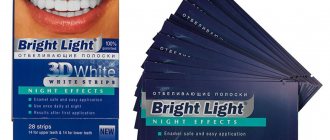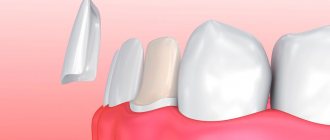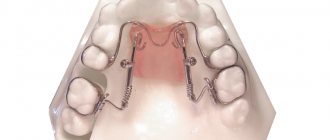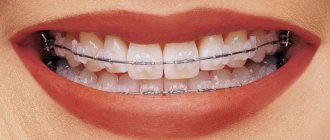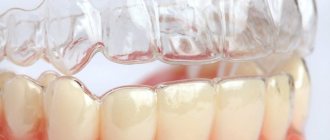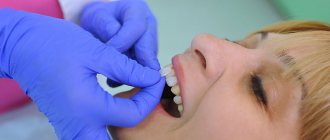The first mouth guards specifically for correcting malocclusion appeared in the last century. True, then they were created in stages - impressions were taken for the first aligner, after it was worn in - repeated impressions and the production of a second aligner, and so on. Today, the patient receives a ready-made set of aligners, the size of which is selected using modern computer equipment.
Indications
- spaces between teeth
- crowding and overlapping of teeth
- open and cross bite (with slight displacement of the jaws),
- changes in the position of the teeth - rotations, tilts.
Contraindications
- allergic reactions to aligner materials (extremely rare),
- severe violations of the position of the teeth,
- significant displacement of the jaw position,
- age up to 12 years.
What are braces and who are they for?
We have known about braces for quite a long time - both in life and in movies we have seen people with characteristic braces on their teeth. Essentially, braces consist of small clasps glued to the teeth with special dental glue, and a metal arch passing through them, connecting them into a single system.
The archwire transfers pressure to the teeth, which causes the misaligned teeth to gradually shift toward a more correct position. As the defects are corrected, the arch must be tightened: for this, the patient needs to visit the dentist once every 2 weeks, and after treatment is completed, he also needs to wear special retainers that will prevent the possibility of reverse displacement of the straightened teeth.
At the same time, there is another method - the use of aligners. What is the difference between braces and aligners? Aligners are transparent aligners made of special plastic that fit tightly onto the teeth and create the necessary pressure to correct misaligned teeth. Speaking about the difference between braces and aligners, it can be noted that braces create many inconveniences in everyday life: they are clearly visible from the outside, they must be thoroughly cleaned after every meal, they are difficult to get used to and serious dietary restrictions must be observed during the period. wearing them.
However, in case of serious malocclusion, it is necessary to wear braces. In addition, aligners are usually used only for adults who have completed their period of jaw growth, although aligners are now being developed for children over 7 years of age. Braces do not have such a limitation - they can be placed on children at almost any age.
In addition, there is a difference between braces and aligners in the force of impact: braces are a more rigid structure that puts more pressure on the teeth, so they can be used to correct more complex situations.
Orthodontic treatment and basic devices
As you know, orthodontists are involved in identifying, eliminating and preventing dental anomalies. In their opinion, regardless of the patient’s age, there is always the opportunity to move the tooth to the right place, as well as to stimulate or inhibit the development of the bone structures on which the teeth are attached. This is due to the compliance of the supporting-retaining apparatus.
There are several ways to perform orthodontic treatment, namely:
- Conservative therapy. It consists of using special devices: braces, transparent aligners, thin overlays on teeth, etc.;
- Surgical intervention. This method is used in difficult situations when it is not possible to eliminate the defect using orthodontic appliances. However, a prerequisite after surgery is the use of braces or transparent aligners.
To understand what is better to choose after surgery - aligners or braces - you should pay attention to the following criteria.
An alternative to braces is aligners.
In many cases, aligners can be used instead of inconvenient braces. Their key feature is that it is a removable structure made of transparent plastic that fits tightly to the teeth. This option is indispensable for those who, for some reason, cannot allow their appearance to change, because braces are clearly visible when talking and smiling, and they will have to be worn for several months, sometimes even up to 2 years. Of course, there are braces that are less noticeable, made of polymer or ceramic materials, as well as lingual braces, which are placed not on the outside, but on the inside of the dentition, but they cannot always be used, and their cost is much higher than usual.
Aligners are an analogue of braces, since they use the same general principle - applying constant pressure to the teeth in order to move them in the desired direction. The only difference is in the design, and as a result, in some functions and properties. Firstly, they are transparent, which makes them very unnoticeable from the outside, and secondly, they can generally be removed during an important meeting or photo shoot. To achieve the desired effect, aligners must be worn 20-22 hours a day, so you can always find time for meals or negotiations to remove the aligners for a while.
The difference between aligners and braces includes several important points:
- aesthetic – unlike braces, they are not visible,
- mechanics of impact – more evenly distributes pressure on each tooth,
- removable - they can be removed, hence there are fewer restrictions on food intake and easier hygiene,
- allergenicity - are made of hypoallergenic plastic, and braces are made of metal.
An orthodontist will help you decide to use aligners or braces in case of dental alignment, based on the specific clinical situation, individual characteristics and requirements of the patient.
Which method of correcting malocclusion pathologies is preferable?
Considering all the features, advantages and serious differences of corrective systems, the choice of patients predictably falls on mouthguards. But the final decision is made by the orthodontist, based on the clinical case, the nature and complexity of dental anomalies, the individual characteristics of the patient and other factors.
Before starting treatment, the patient undergoes an X-ray examination to accurately identify all pathologies. For a better understanding and choice of the optimal correction technique, it is worth undergoing a 3D scan and planning the future result.
To learn more about orthodontic treatment and find the best solution, call and schedule a consultation!
Pros and cons of aligners and braces in use
Comparing aligners and braces allows you to understand the question of which technology is best to choose in your case. Each technology has its own advantages and disadvantages, and for convenience we will summarize them in a table.
| Comparison options | Aligners | Braces |
| Appearance | Transparent aligners | Locks. glued to the teeth, and a metal arch connecting them |
| Color | Transparent | Any |
| Material | Polymer | Metal/Polymer/Ceramics |
| Allergenicity | No | Yes |
| Are they suitable for children? | No | Yes |
| 3D modeling of jaws on a computer | Yes | No |
| Discussion with the doctor of the result and patient participation in treatment | Yes | No |
| Preparation time | 7 days | 1-2 days |
| Installation time | 45-60 minutes | 3-6 hours |
| Taking impressions before installation | Oral scan + impressions | Yes |
| Treatment speed | 30% faster | Slower |
| Impact mechanics | Simultaneous rotation and displacement of the tooth in the desired direction due to tight coverage | Consecutive displacement in one direction or another and rotation |
| Risk of caries | No | Yes |
| Possibility of enamel remineralization | Yes | No |
| Possibility of injury to the mucous membrane | No | Yes |
| Frequency of visits to the doctor for correction | Every 4-6 weeks | Every 2 weeks |
| Dietary restrictions during treatment | Almost not | Yes |
| Possibility to remove the structure for eating or cleaning | Yes | No |
| Food getting stuck between teeth | No | Yes |
| Bad breath after eating | No | Yes |
| Difficulty in oral hygiene | No | Yes |
| The need to brush your teeth after every meal | No | Yes |
| The need to use dental floss and toothpicks | If necessary | Necessarily |
| Using a special toothbrush | No | Yes |
| Toothbrush lifespan | Standard | Short (due to increased wear) |
| Opportunity to see results before treatment begins | Yes | No |
| Need to be worn constantly | No | Yes |
| Psychological comfort and self-esteem | Yes | No |
| Aesthetics of appearance | High | Low |
| Feeling of discomfort | No | Yes |
| Possibility of pain at the beginning of treatment | No | Yes |
| Impaired diction | Almost not | Yes |
| Protecting teeth from injury | Yes | No |
| Ease of installation and wearing | Yes | No |
| Possibility of self-replacement | Yes | No |
| Possibility of peeling off | No | Yes |
| Disruption of the usual way of life and forms of communication | No | Yes |
As can be seen from the above comparison, aligners are more convenient in almost everything. Braces cause more discomfort, require changes in the usual lifestyle and diet, and, in fact, the only case when braces are preferable is when the patient is a child. Therefore, when choosing between braces or aligners, according to the orthodontist, it is better to prefer aligners.
Advantages of aligners over braces
The two main advantages - aesthetics and wearing comfort - are due to the design of this product. This allows you not to experience embarrassment during treatment, as happens when wearing braces, when a person is embarrassed to smile and talk, experiencing stress and becoming withdrawn, refusing to communicate. Aligners eliminate such problems - they make you look the same as usual, and in extreme cases they can be removed altogether.
Aligners are more effective than braces in another respect: there are almost no restrictions on food intake. Even solid foods can be eaten if they are removed before meals. It is impossible to remove the braces for a while, so you will have to eat in them, which means you will have to give up solid food, which can break the structure, and after eating, rinse your mouth thoroughly and brush your teeth using special brushes and toothpicks, since food gets stuck between them much more strongly. teeth.
Well, difficulties in oral hygiene will result in the development of caries if the patient allows himself to relax and not be too diligent in caring for the oral cavity. When using aligners, such problems do not arise, you can eat and brush your teeth as usual.
Finally, what makes you choose aligners instead of braces is their purely medical effectiveness - treatment with aligners is faster, and you can change the aligners yourself if necessary. Aligners cover the teeth more tightly and transfer the load to them more evenly, allowing them to be moved in several axes at once, which speeds up treatment and at the same time makes it safer and more comfortable.
What is more expensive - braces or aligners?
In some individual cases, expensive branded aligners may be more expensive than cheap braces, especially with long-term treatment involving many stages. But if the comparison is made correctly, comparing cases of the same degree of complexity, then the difference in the price of braces or aligners will either be minimal, or even aligners will be more profitable.
Imported mouthguards from foreign manufacturers are more expensive. Our clinic cooperates with Star Smile, a leading domestic manufacturer of aligners, which, with completely similar quality, have a much lower price. This allows us to offer treatment for malocclusion using aligners at the most affordable prices.
Therefore, to the question: what to choose: braces or aligners? – our doctors answer unequivocally – choose aligners. This will provide greater comfort during treatment, better aesthetics and will be much more profitable.
Effective models
In their practice, specialists from our network of clinics use orthodontic aligners that meet the following requirements:
- high impact efficiency;
- harmlessness to human health;
- Positive assessment from patients and orthodontists
Many types of aligners meet these requirements, but the following models are especially popular:
- Invisaling (USA) - made to individual sizes from thin polymer, practically invisible to a prying eye. The advantage is that it can be used from the age of 8;
- FlexiLigner - effective in difficult cases: open and cross bites, dystopia (deviation from the correct growth vector), rotation (rotation).
- KidsLight - this line is a modification of the FlexiLiner brand for children over 5 years old.



